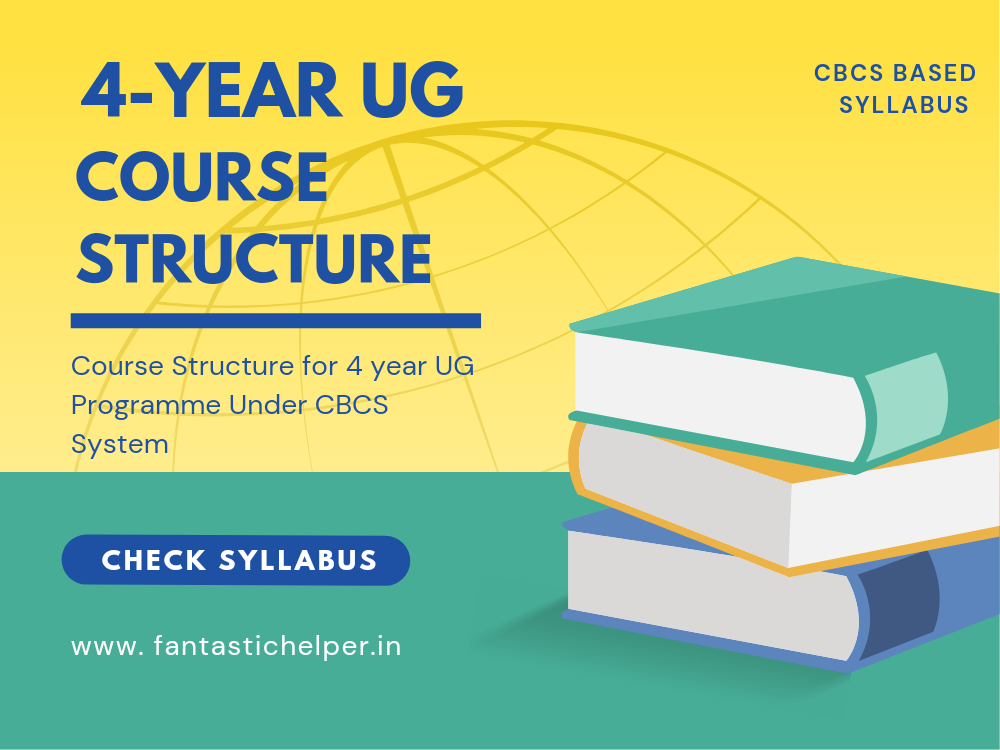Unlocking Success: Navigating the 4-Year UG Programme Under CBCS with a Comprehensive Course Structure
Unraveling the Essence of Choice-Based Credit System (CBCS)
The academic landscape is evolving, and so is the structure of undergraduate education. In this dynamic era, universities are embracing a revolutionary approach known as the Choice-Based Credit System (CBCS). Let’s embark on a journey through the course structure of a 4-year UG Programme under CBCS, delving into the intricacies of Major Courses (MJC), Minor Courses (MIC), Multidisciplinary Courses (MDC), Skill Enhancement Courses (SEC), Value-Added Courses (VAC), Ability Enhancement Courses (AEC), Internships (INT), and Research Projects (RP) / Dissertations.
Section 1: The Core Components of CBCS
Building Foundations with Major Courses (MJC)
Major Courses (MJC) form the backbone of the CBCS, offering students a deep dive into core concepts, principles, and laboratory skills. This section explores the mandatory nature of MJCs, their grading system, and the flexibility they provide with multiple entry and exit options.
Nurturing Specializations with Minor Courses (MIC)
In a world of evolving disciplines, Minor Courses (MIC) play a pivotal role in incorporating emerging areas into the curriculum. This part examines the growth of specific subjects, the inclusion of new branches, and how students can tailor their studies based on their interests within their faculty.
Section 2: Beyond Boundaries – Exploring Multidisciplinary Courses (MDC)
The Intersection of Knowledge
Multidisciplinary Courses (MDC) offer a holistic educational experience by pooling courses from various disciplines. Here, we explore how students can choose three MDCs from a list provided by their department, fostering a comprehensive understanding of diverse subjects.
Section 3: Hands-On Learning – Skill Enhancement Courses (SEC)
Crafting Competence
Skill Enhancement Courses (SEC) are designed to provide practical, hands-on training across all disciplines. This section outlines the purpose of SECs, the skill-based instruction they offer, and how students can choose courses tailored to their interests.
Section 4: Enriching the Mind – Value-Added Courses (VAC)
A Tapestry of Learning
Value-Added Courses (VAC) contribute to the all-round development of students, emphasizing personality building, ethical values, and critical thinking. This part explores the common pool of courses offered by different disciplines and their role in shaping well-rounded individuals.
Section 5: Knowledge Enhancement – Ability Enhancement Courses (AEC)
Bridging Knowledge Gaps
Ability Enhancement Courses (AEC) focus on knowledge enhancement in key areas such as language and literature, environmental science, and sustainable development. This section discusses the mandatory nature of AECs and their role in broadening students’ intellectual horizons.
Section 6: Real-World Experience – Internships and Research Projects
Bridging Theory and Practice
Internships (INT) and Research Projects/Dissertations (RP) provide students with real-world exposure. Here, we explore how these experiences contribute to practical learning and help students apply their theoretical knowledge in professional settings.
Conclusion: Mapping Your Educational Journey
As you embark on this 4-year UG programme under CBCS, understanding the intricacies of the course structure is crucial. This comprehensive guide aims to equip you with the knowledge to navigate your academic path successfully, ensuring a well-rounded and fulfilling educational experience.





Download CBCS Syllabus Of All Subjects
UG CBCS Syllabus – Click Here
PG CBCS Syllabus – Click Here
Frequently Asked Questions (FAQ) – 4-Year UG Programme Under CBCS
Q1: What is CBCS, and how does it differ from traditional academic structures?
A1: CBCS stands for Choice-Based Credit System, offering students flexibility in choosing courses and creating a personalized academic journey. Unlike traditional systems, CBCS emphasizes skill enhancement, multidisciplinary learning, and a credit-based approach.
Q2: What are Major Courses (MJC), and why are they mandatory?
A2: Major Courses are core subjects providing in-depth knowledge in main branches. They are mandatory to ensure a solid foundation for students pursuing an undergraduate degree, and they offer flexibility with multiple entry and exit options.
Q3: How do Minor Courses (MIC) contribute to the curriculum?
A3: Minor Courses incorporate emerging areas and sub-disciplines, allowing students to tailor their studies based on their interests within their faculty. They add diversity to the curriculum and reflect the growth of specific subjects.
Q4: What is the significance of Multidisciplinary Courses (MDC) in CBCS?
A4: MDCs provide a holistic educational experience by offering courses from various disciplines. Students can choose three MDCs from a list provided by their department, fostering a well-rounded understanding of diverse subjects.
Q5: How do Skill Enhancement Courses (SEC) benefit students?
A5: SECs focus on hands-on training and skill development across all disciplines. They provide practical competence and allow students to choose courses tailored to their specific interests, enhancing their employability.
Q6: What are Value-Added Courses (VAC), and how do they contribute to holistic development?
A6: VACs are a common pool of courses offered by different disciplines, emphasizing personality building, ethical values, critical thinking, and more. They play a crucial role in shaping well-rounded individuals beyond academic knowledge.
Q7: What is the role of Ability Enhancement Courses (AEC) in the curriculum?
A7: AECs focus on knowledge enhancement in areas such as language, literature, environmental science, and sustainable development. They are mandatory for all disciplines, broadening students’ intellectual horizons.
Q8: How do Internships (INT) and Research Projects (RP) contribute to the educational experience?
A8: Internships provide real-world exposure, bridging the gap between theory and practice. Research Projects/Dissertations allow students to apply theoretical knowledge in-depth, fostering a deeper understanding of their chosen field.
Q9: Can I choose courses based on my interests, and how flexible is the course structure?
A9: Yes, the CBCS allows students to choose courses based on their interests, providing flexibility in creating a personalized academic path. The system offers multiple entry and exit options, enhancing the overall flexibility.
Q10: How long is the UG programme, and how is it structured across semesters?
A10: The UG programme spans four academic years, with each academic year consisting of two semesters—Odd semesters (I, III, V, VII) from July to December and Even semesters (II, IV, VI, VIII) from January to June. The certified program of study extends up to eight semesters.
